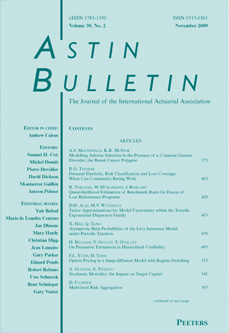 previous article in this issue previous article in this issue | next article in this issue  |

|
Document Details : Title: Survival Analysis on Pedigrees Subtitle: A Marked Point Process Model Author(s): MACDONALD, Angus S. Journal: ASTIN Bulletin Volume: 40 Issue: 1 Date: 2010 Pages: 35-64 DOI: 10.2143/AST.40.1.2049218 Abstract : Regulation of insurers’ use of genetic information means actuaries are interested in age-at-onset of genetic disorders. Arjas & Haara (1984) suggested marked point processes (MPPs) as useful models for life history data with complex covariates. Age-at-onset distributions (or equivalently, hazard rates) in respect of inherited disorders are often estimated from pedigrees, which are life histories with unusually complex covariates, as well as strong dependencies induced by shared genes. Since Elston (1973) parametric models have often been used, conditioning the likelihood on known genotypes. However, a genotype identified by a presymptomatic genetic test is a form of internal covariate (Kalbfleisch & Prentice, 2002). We propose a very general MPP model of a pedigree, including presymptomatic genetic testing, (‘the full model’) and show under what circumstances the partial model leading to Elston’s likelihood is valid. In practice, pedigrees are often ascertained retrospectively. Many such events can be modelled by augmenting the natural filtration of the MPP. We show that, except in simple special cases, the partial model is no longer valid, and the resulting likelihoods appear to be intractable. In particular, ascertainment interacts even with independent censoring so that likelihoods no longer factorize. For one simple special case — studies of sibships — we generalise a classical result to age-at-onset data. We conclude that the study of genetic conditions with variable age at onset gains insights from the underlying principles of survival analysis in their modern form, but that great care is needed in translating epidemiological studies into actuarial models. |
